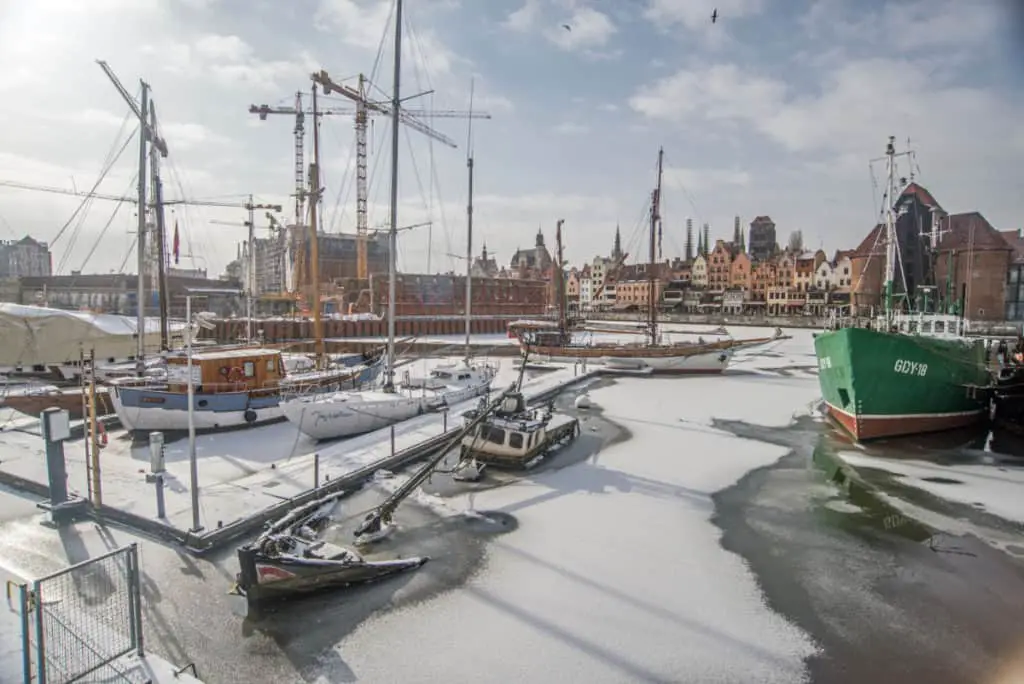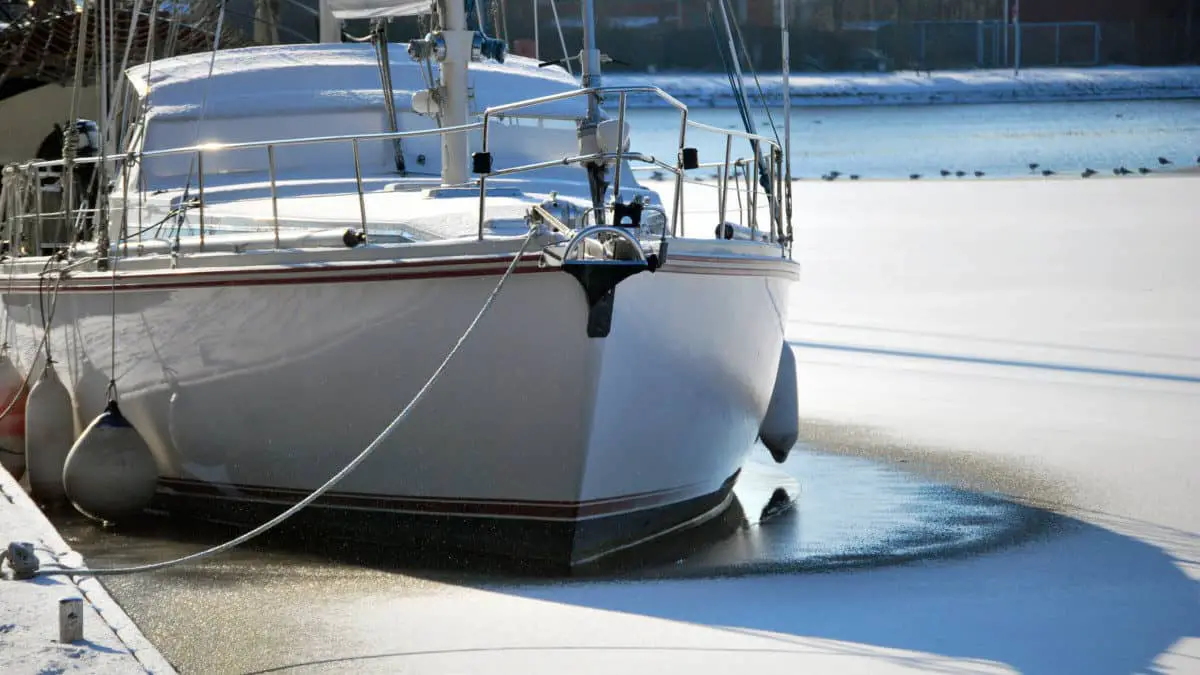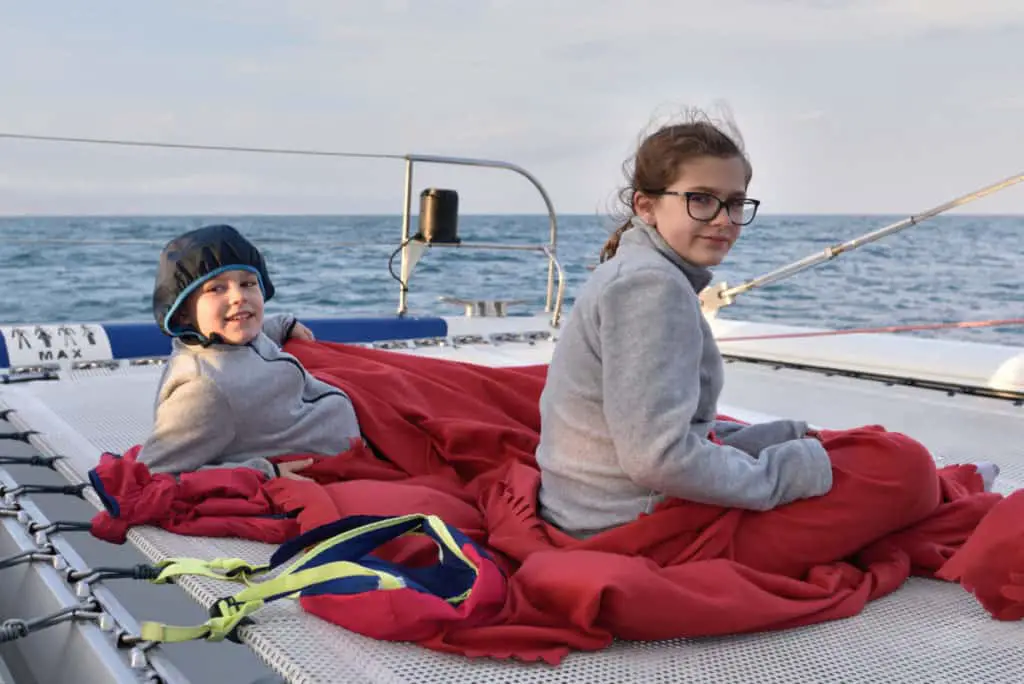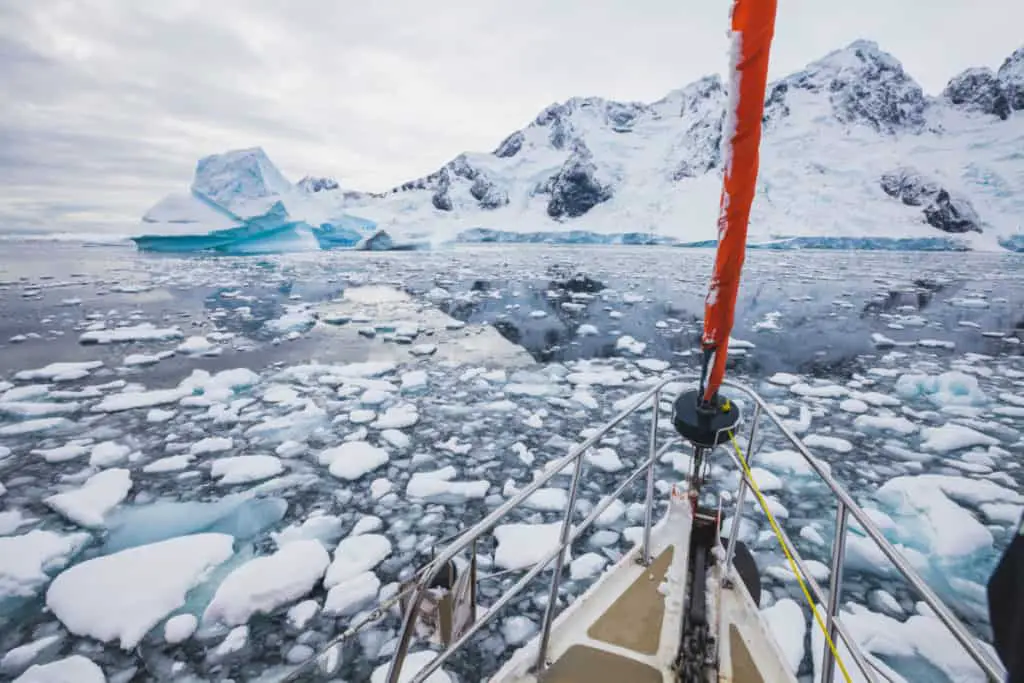As an Amazon Associate, we earn from qualifying purchases. We may also earn commissions if you purchase products from other retailers after clicking on a link from our site.
I’m from Sweden, as you might know, Sweden is positioned partly above the arctic circle, so it gets really cold up here during the winter. The most common questions I get are, doesn’t it get cold inside, how do you use the toilet, etc? Today I want to share my tips on how to not only survive but thrive during the cold months of the year, if I can live in a van or sailboat comfortably in -20, then so can you!
Here are a few tips for the beginner liveaboard during winter:
- Prepare your boat with shrinkwrap and enough insulation.
- Invest in boat-safe heaters and air monitoring system.
- Find a de-bubbler or de-icing device for your boat.
- Bundle up when you can.
- Purchase a tea or coffee maker for your boat.
As you begin your journey of boat living 365 days a year, know that you’ll never face anything as tricky as the winter months (and possibly winter storms). The benefits outweigh the costs, though. If you want to continue your boat living all year long, read below to explore the tips further.

1. Prepare Your Boat With Enough Insulation
First and foremost, you must prepare your boat for the winter cold. It’s something you have to do whether or not you’re planning on living aboard during the winter months; so don’t let this step turn you off of your winter living plans.
If you choose to keep your boat in the water and don’t pay attention to the details below you will damage your boat to a degree that can be very costly.
To make your boat habitable for the winter, you must consider a few things. They’ll support your environment more than any of the tips below combined:
Install Quality Insulation In Your Boat.
Just like your land home, your water home may need some insulation if you expect to get through the winter without suffering. You can get insulation professionally installed (don’t get too creative). Many people use improvised insulation so let’s talk about why that is not the best of options.
Use XPS cell foam insulation, this material is water-resistant and prohibits moisture from entering the foam, and stops mold, the boat will be cold on the outside and warm on the inside so there will be condensation.
Make sure you insulate water hoses and water tanks, if these freezes they will crack, and once the temperature is above freezing the water will start entering the boat.
Ventilation is key to keeping moisture and therefore rust and mold out. You also want to dry your shoes and outdoor wear after a day outside. It might feel counterintuitive to let some of the warm air out, but unless you are getting a dehumidifier then this is the way.
Ventilation will also be vital for getting rid of toxic fumes from diesel etc.
“and remember, if you are using a propane burner the residues add very much water to the air, so it’s even more important to have good ventilation.”

2. Invest in Boat-Safe Heaters and Air Monitoring Systems
Fortunately, we are far past the days of needing a stick-and-log fire to get warm, even though it is super cozy it is very inefficient and time-consuming. Space heaters have their disadvantages, but they’re made explicitly for use in a boat.
I would recommend getting an electric or diesel heater, much to the fact discussed above. A propane burner adds a lot of moisture to the air, and the electric heater just “adds” dry heat. Do NOT get a propane heater!
Investing in a boat-safe heater will support your warmth in those cold winter months. You might consider the Caframo Dehumidifier, made specifically for marine use and RV living. It helps warm the cabin, but it mainly helps combat mold and mildew.
When looking to buy a heater, two things are important, wattage, and circulation. a general rule: 3000w will keep a comfortable heat in up to 35ft monohull in as low as freezing. This is under the assumption that the boat is insulated with at least 30mm XPS on the floor, walls, and ceiling, and that there is proper ventilation for the warm air to reach all parts of the boat.
So using this as a rule of thumb you can roughly estimate what you need for your boat. If you have a catamaran, well as always in the multi-hull world, you will have to double the numbers.
I use a 3000w diesel heater in my van, and it works perfectly, I never run it above 50% output and it keeps my van nice and warm well below -20. I can definitely recommend it
Another option is this one, which works like the thermostats in traditional homes. The space heater will turn off when the desired temperature has been reached, meaning little interaction with you during cold nights. I haven’t tried this exact one, but you get the idea.
Mr. Heater Buddy is a best-seller and runs on propane. You won’t have to worry about plugging it into any electric outlets or sources, but using a gas such as propane on your boat comes with its disadvantages and I do not recommend it!
Regardless of what you choose, you should always have a carbon dioxide and monoxide detector on your boat to monitor the air in case your ventilation isn’t adequate or the exhaust from something outside enters your boat.

3. Find a De-Bubbler or De-Icing Device for Your Boat
De-icers can support your boat in the winter months if you use them correctly. Depending on the size of your boat, you may need to get multiple de-icers, but even one de-icer will do a great deal when you are docking your boat for the night.
These machines work by circulating the water close to the hulls of your boat and since moving water freezes at a slower rate than still water, the freezing is “delayed”.
Typically, those living in their boat will dock in the same place every night. One needs to plan around when dealing with the water freezing, melting, and refreezing. Getting a de-icer can keep the shallow area around your boat melted.
This is good for multiple reasons, firstly it reduces the frictions against your hulls, or hull, removing both noise and damage to your gel coat. Secondly, it keeps the water around your inlet and outlet free from ice so that you are able to use your water pumps and toilets.
Dock bubblers are the same thing, just under a different name. Either will help keep the space around your boat from being frozen, meaning a warmer boat for you. Not to mention, it’ll protect your boat from damage caused by ice.

4. Bundle Up When You Can
This is such a simple tip, but it goes a long way! Just like you would in the thick of winter in your own home on land, you might want to bundle up on your boat.
Now, depending on the heat situation in your house, bundling up on the boat is going to be dramatically different. A hoodie or sweatshirt just won’t do. However, it may be impossible to get done what you need to get done in an oversized puffy coat and mittens. Especially if you live on your boat to enjoy your retirement, being overstuffed in winter clothes can hinder your hobby time.
Two ways to combat this are to dress in very intentional layers and to invest in extra warm blankets. Not all products, t-shirts, or blankets are made the same.
Below, I’ve detailed these two tips and suggested some products, there’s no need to buy exactly these products, they are more intended for you to understand the basic idea of winter clothing in humid conditions.
Dress in Layers
Dressing in layers is pretty self-explanatory, but the extent of how many layers you’re willing to wear may depend on your plans for the day. While a tank top, t-shirt, long-sleeves, hoodie, and overcoat will keep you warm, it might not be suitable for reading in bed or cooking breakfast.
Comfortability and warmth are essential to successful layering.
As mentioned above, not all clothing items are created equal. Two long-sleeves made of different materials may feel completely different. Being intentional about what clothes you invest in will keep you much warmer than adding layer after layer. I’ve added some essentials for you to consider below.
Runhit Thermal Underwear
Thermal underwear makes for a perfect base layer for daily activities. Also sometimes called “long johns,” thermal underwear are fitted but not skin tight, making them optimal for movement but still super warm. This thermal underwear from Runhit is lined with microfleece to keep you extra warm and cozy. It’s machine washable, too.
Busy Socks’ Winter Warm Thermal Socks
Winter Warm Thermal Socks are warmer than the average sock. Sure, they may be a little more expensive, but adding layers upon layers of cheap socks adds up. In the end, the Winter Warm thermal socks will come out as a better deal. They’re insulated and lined with fleece to keep your toes warm.
I would also add a pair of slippers similar to these.
Gihuo Men’s Sherpa Lined Athletic Sweatpants
Fleece-lined sweatpants are a good idea because the looseness makes it possible to layer underneath without getting bulky. These particular sweatpants are lined in a warm, sherpa material to keep you warm.
Venustas Women’s Heated Vest
Many people aren’t aware that they can buy clothing with the heaters built right in. This Venustas heated vest comes with a battery pack that you can even charge your phone and stay warm for ten hours.
I have been using heated gloves from outdoor research (OR) for the last 5 years, and I promise you, electrically heated clothes are THE BEST and worth every dollar.
IZEEPE Electric Blanket
This heated blanket plugs in with a USB cord, so you don’t have to worry about finding an electrical outlet. Besides the minor USB cord, it’s also essentially cord-free, so there are no worries about it getting tangled up on the boat, either.
Having a heated blanket can be a game-changer for when you’re lying in bed, relaxing on deck, or lounging for the day.
HotHands Hand and Toe Warmers
For your coldest nights, you can purchase warmer packs for your hands and toes. To use these HotHands warmers, all you have to do is manipulate the packets in your hands for them to start to heat up. If you want a more sustainable option, you can use the BESKAR Rechargeable Hand Warmer, which is rechargeable.
I usually put these in my pockets so if I get wet and cold a break one open and it gives me instant heat, perfect for winter sailing after your hands have been deep-frozen.
5. Bonus Tip: Purchase a Tea or Coffee Maker for Your Boat
There’s a reason that people usually drink hot chocolate in the winter instead of the summer.
Some research has indicated that having a hot drink isn’t adequate for your overall body temperature. But this doesn’t mean having a warm mug in your hands isn’t as effective as wearing a pair of mittens or using a hand warmer.
Having a nice, warm drink in your hands can help warm you up immediately. Getting a coffee maker or tea kettle fit for your boat’s kitchen might be an excellent way to get that extra warmth in.
Can You Live on a Boat During Winter?
If you’re new to the boat-dwelling lifestyle, you may wonder what is considered normal and taboo. Indeed, being on a boat in the winter must be the latter.
During winter, you can live on a boat as long as you prepare for it. When people dedicate themselves to the liveaboard lifestyle, they often commit to it year-round. It’s normal to find people living on their boats in the winter, although this is usually done in warmer climates.
Don’t worry too much about the cold, you can always add insulation and get more clothes and heaters!

Can a Boat Stay in the Water During Winter?
Whether or not you plan on staying in your boat, you may wonder if the vessel can remain in the water during winter.
A boat can stay in the water during winter as long as it’s properly winterized. Depending on the rules of the dock or marina where you have your boat parked, you can prepare your boat to have it stay safely in the water.
Do check with the administrators for your dock or marina before leaving your boat there during the winter, though. Sometimes, there are rules for how long a boat can stay docked or what needs to be done to ensure the boat is winter-ready.
How Do You Keep Warm?
You can keep warm by adding insulation or shrinkwrap/tent to your boat. Make sure you also prepare your boat with tons of warm clothing and blankets. Additionally, consider buying heated clothing items or blankets for the boat.
What you spend on keeping warm depends on your budget and preference, but at the very least, you should make sure your boat is insulated and winterized before deciding to stay on it for the cold season.
Which (Type) Boats Can Be Used During Winter?
When considering whether or not you want to reside on your boat for the winter, you may begin to have doubts about your boat’s capability.
During winter you can use a catamaran, monohull, or any other type of boat as long as you prepare it properly for the cold. Your comfortability as the temperatures drop will also determine whether or not you should use a boat in the winter.
Some boats are better than others for living in the winter, but preparation is vital. You may consider doing some DIY winterization if you worry your boat won’t hold up to the winter.
Conclusion
Living aboard a boat during the winter has numerous benefits, and doing it right can solidify your plans to live in a boat residentially full time.
Here are some things you should add to your to-do list to prepare yourself and your boat for the winter:
- Winterize your boat and get professional help with insulation if you are unsure how to install it yourself.
- Invest in high-quality and boat-safe heaters.
- Be intentional about the clothing you purchase.
- Get creative with the other products you purchase for warmth, such as heated blankets or hand warmers.
Sources
- Westshore Marine: Benefits of Shrink Wrapping Your Boat
- Better Sailing: Best Boat Heaters for Your Winter Trip
- CDC: Prevent Carbon Monoxide Poisoning on Your Boat
- NPR: Near D.C.’s Corridors Of Power, A Channel Of Laid-Back Houseboat Life
- NOLS: Do Hot Drinks Really Warm You Up?
- Kasco: Tips on Using Kasco De-Icers
- Better Boat: Dock Bubblers to Melt Away Your Winter Boating Woes
- Improve Sailing: 9 Tips for Winterizing a Boat that Stays in the Water
- Boats.com: In the Water Winter Boat Storage
- Boat Owners Association of The United States (BoatU.S.): Winterization
- YouTube: How to Shrink Wrap a Boat / Dr. Shrink, Inc.
- YouTube: The Boat koozie – Easy Insulation for an old Boat.
